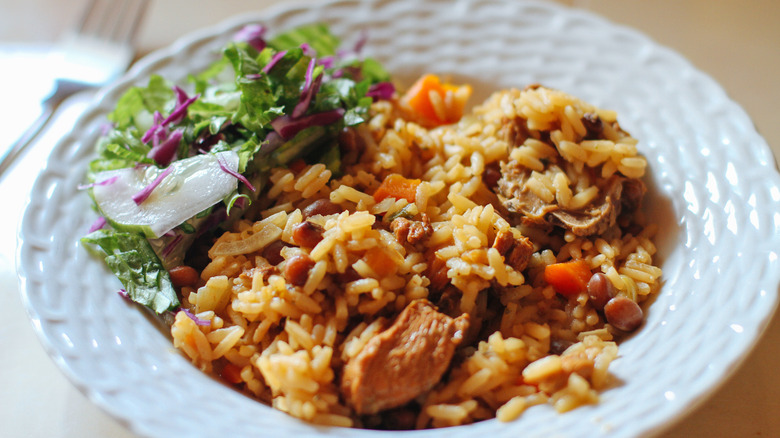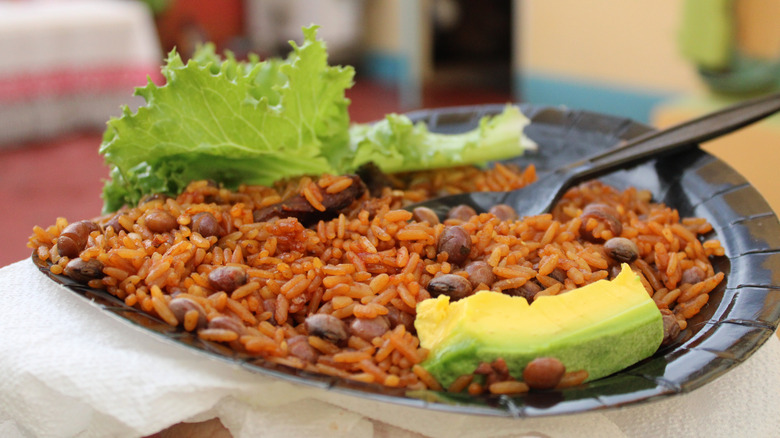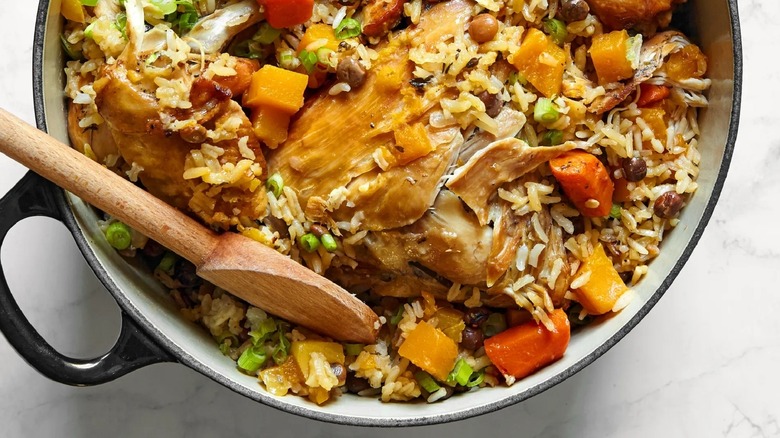Pelau Is The Comforting Trinidadian Dish That's Fit To Feed A Party
It's hard to beat the encompassing nature of a rice dish. Whether it's a fried rice fridge cleanout or a loaded seafood paella, the grain will sop up a range of delicious flavors. It's no surprise that pilaf — one of the most versatile rice applications — is so widespread. Traditional preparations exist from India and Central Asia to the Middle East and the Balkans.
There's even a pilaf rendition in the Caribbean, originating from Trinidad and Tobago. Called pelau, the dish integrates sugar-seared meats, pigeon peas, sauces, spices, and vegetables. The aromatic mixture bursts with flavor, a single bite yielding bold, bright notes underlaid with sweetness and savory complexity. Plus, there's textural diversity, too, with bites of caramelized meats, vegetables, and rice melding into one. Despite such complexity, at its core, pelau is still a rice dish at its most comforting. A one-pot meal prepared for sharing among family and friends. Let's dive into how this delicious Trinidadian dish came about.
Background of pelau
Pelau exemplifies Trinidad and Tobago's diverse array of culinary influences. The dish's strongest resemblance is to other pilafs, which originated in Asia. East Indian workers brought rice for growth to the Carribean nation in the early 19th century and introduced aromatic rice-preparation techniques. Pelau's other prominent contributions — the searing of meat in sugar and the pigeon peas — hail from Africa. Such an influence arrived on the islands due to the enslaved labor forced to man sugarcane plantations.
Further culinary infusions are evident in other components, too. The utilization of frying oil is owed to European colonizers, with especially the Worcestershire sauce bearing a British touch. The herbs utilized in green sauce trace back to indigenous settlers. Today, pelau is a Trinidadian staple that unites all. Enjoyed in restaurants and prepared at home, it's a delicious rice dish that melds the country's complex history into a single pot.
How to prepare pelau
This complex rice pilaf integrates a wide variety of components and flavors, all tied together with rice. A long, white version of the grain — such as jasmine – is employed for the dish. And when it comes to the utilized protein, it's typically beef or chicken, although pelau readily incorporates other meats, too. Coconut milk ties components together, and pigeon peas, a type of lentil, add a textural component. Plus, a scotch bonnet is stirred in for heat. Such components are the typical cornerstone of pelau; further flavors depend on the recipe. Spices range from bay leaf, cinnamon, and star anise to local favorite green seasonings. And sauces span a worldly influence, including Worcestershire, hot sauce, soy sauce and ketchup.
Preparation starts with the marination of the chosen protein in the sauces, spices, and aromatics. After a few hours, a pot is heated with a generous pour of oil. Turbinado sugar, or another natural cane sugar, is stirred in and browned for a few minutes. Next, the marinaded meat is introduced and caramelized. Depending on the recipe, some then set the meat aside or add the rice, peas, and optional carrots and peppers to the pot to cook together. Regardless, a combination of chicken stock and coconut milk is used to simmer the pilaf. The scotch bonnet is traditionally added whole on top, and after thirty to forty minutes, the pelau is complete. Like with paella, the dish forms a delicious crust on the bottom, called bun bun.


